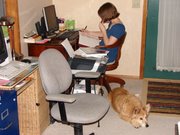Katie Meyers
Online Lab One
History

(found at http://www.southwestschools.org/jsfaculty/Microscopes/history.html)
Influences
The ancient Greeks and Romans
The founding fathers: Janssen, Hook, Leeuwenhoek
Hans and Zacharias Janssen were a father/son team from
Robert Hooke (1635 – 1703) was an Englishmen who improved on and invented many mechanical devices (for example, he described the telegraph system in 1684). One of his mechanical improvements was the compound microscope circa 1660.
Anton van Leeuwenhoek (1632 – 1723) was a commoner without a formal education who made a simple microscope (one lens). He is also known for making the best microscopes of that time period.
Ernst Leitz invented a microscope with a revolving nosepiece in 1873.
August Kohler improved microscopes to portray sharper images circa 1880.
Katherine Blodgett developed non-reflecting (“invisible”) glass in 1917.
Max Knoll and Ernst Ruska build the first electron microscope in 1931.
Ernst Ruska produced magnifications on the electron microscope that surpassed all possible magnifications on a compound light microscope in 1933.
Periods and styles of microscopes (with image examples)
Beginning microscopes – 1670-1740
 (found at http://www.arsmachina.com/loeuwenhoek.htm)
(found at http://www.arsmachina.com/loeuwenhoek.htm)Early Development – 1740-1840

(found at http://www.arsmachina.com/jones.htm)
Evolutionary Years – 1825-1860

(found at http://www.arsmachina.com/ross1428.htm)
Early Americans – 1838-1900

(found at http://www.arsmachina.com/s-zentmayer1221.htm)
(found at http://www.arsmachina.com/nachet2_binoc.htm)
(found at http://www.arsmachina.com/ladd1188.htm)
Continental Style – 1880-1910

(found at http://www.arsmachina.com/leitsing.htm)
Jug-handle Style – 1900-1920 (variation of the popular Continental style)
(found at http://www.arsmachina.com/bljug1392.htm)
Contemporary Classics – 1920-1975

(found at http://www.arsmachina.com/bl1945.htm)
Microscope Parts
The stage is the platform on which the specimen rests. It is adjusted primarily when looking at the microscope, although it is also adjusted with various knobs while looking through the microscope. The initial adjustment is when you put your tray holding the specimen into place. This takes place while looking at the microscope. Later, while examining your specimen through the oculars, you will adjust the stage with the focus knobs.
There are two focus knobs, the coarse focus knob and the fine focus knob. The coarse focus knob is first used to adjust the stage as high as it can go while looking at the microscope. Later, it is used while looking through the microscope to locate the specimen through the oculars. The fine focus knob is used to adjust the clarity/focus of the specimen image while looking through the microscope. In addition to these two focus knobs, there are the two X/Y knobs, which are used while looking through the microscope to center your specimen. This is an especially handy thing to do at a lower objective (or power) before you adjust to a higher objective, as it will ensure that the specimen will still be in view when you change to a higher power.
The iris is the part of the microscope that lets light through onto your specimen. Depending on the objective power and the specimen, you can change the iris diaphragm by using the iris lever to adjust the amount of light shining on the specimen. This is used while looking through the microscope.
The oculars are the two eyepieces one looks through while examining a specimen. When first looking through the microscope, these may be necessary to adjust if there is more than one circle in view. Adjust the oculars until the circles converge and there is only one circle in view. Without adjusting these, the rest of one’s attempts to view a specimen through a microscope could very well be impossible.
The objectives on a microscope are the different power “nozzles” (e.g. 4X, 10X, 40X, 100X) that can be adjusted, depending on through which power you want to view a specimen. When initially looking at the microscope (before looking at your specimen through the microscope), always set it on the lowest objective. Then, when you look through the microscope, you can “stair-step” up to whichever objective you desire, with the help of your focus knobs, X/Y knobs, and iris.
Lab One Results
Here is a picture of an onion root tip at 40X magnification

Conclusion
The microscope is a vital part of today’s (and yesterday’s) sciences. For example, the discovery of the cell was made possible only by the invention of the microscope. Science has advanced a great deal since then, yet we still heavily rely on the abilities of microscopes. In the end, I find the definition of “microscope” from the Online Etymology Dictionary (http://www.etymonline.com/) to summarize: “an instrument for viewing what is small (impossible to view with the naked eye); means of viewing”.



No comments:
Post a Comment